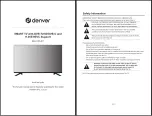
3 Connections and setup
Refer to your TV’s Quick Start Guide or other provided
documentation to for model-specific information about attaching
the base or a wall mount and making connections to AC power and
to your other audio/video devices. The following information
applies to all Roku TV models.
Connecting an antenna, cable, or satellite box
If you are using an antenna, CATV cable without a set-top box, or
a cable or satellite box that has only an antenna output, connect
a 75-ohm coaxial cable (not provided) from the device to the ANT/
CABLE input on the TV.
Tip(s)
●
If you are using an antenna with a 300 ohm twin-lead cable,
you need to use a 300-to-75 ohm adapter (not provided) to
adapt the twin-lead cable to a connection that is compatible
with the TV’s antenna input.
●
If you receive your TV stations through a set top box from a
cable or satellite TV provider, connect it to the TV using the
best connection method available. From most to least
desirable:
–
HDMI
®
input
– Digital HD and SD video
–
AV input
– analog SD video
–
Antenna input
– analog SD video using NTSC
Connecting external equipment with a composite AV
video cable
If the best connection available on your device is AV or composite
video output, connect it to the TV using a composite AV cable (not
provided). Composite AV cables typically have three RCA-type
plugs on each end, color coded as follows:
–
Yellow
– Video
–
Red
– Audio, right channel
–
White or black
– Audio, left channel
Connect each plug to the corresponding connector on the device
and on the TV.
Note(s)
●
Select models have an AV Input that looks like a headphone jack. Use the
breakout cable (included) to adapt this input to the three RCA-type plugs on
your composite cable.
Connecting external equipment with an HDMI
®
cable
If possible, connect your devices using HDMI
®
cables (not
provided). They help to provide the best video quality and also
carry audio signals, so that only one cable is needed. For better
picture quality, we recommend that you use cables designated as
High Speed HDMI
®
Cables.
Tip(s)
●
You might need to configure the device to send its signal
through its HDMI
®
connector
The connector labeled
HDMI IN (ARC)
has the additional ability to
use the audio return channel to send digital audio to a receiver or
sound bar, as explained in
Connecting an AV receiver or digital
sound bar
L
p. 11
Connecting headphones or analog sound bar to the TV
You can connect headphones or an analog sound bar (not
provided) to the TV’s headphone jack.
Tip(s)
●
Inserting a plug in the headphone jack disables the sound from
the TV’s built-in speakers.
Warning
Loud noise can damage your hearing. When using headphones, use the
lowest volume setting on your headphones that still lets you hear the sound.
Select models also have an audio line out connection that is not affected by
TV volume or mute settings and does not disable the TV speakers. Use this
connection when you want to use your amplifi er or sound bar to control the
TV volume. To turn off the TV’s built-in speakers, in the Home screen menu,
navigate to
Settings
>
Audio
>
TV speakers
and change the setting.
Connecting headphones to the Roku Enhanced Voice
Remote
Select Roku TVs come with the Roku Enhanced Voice Remote. On
these models, you can connect headphones to the jack on the left
side of the remote.
Tip(s)
●
Inserting a plug in the remote’s headphone jack disables the
sound from the TV’s built-in speakers or attached receiver or
sound bar. The volume and mute controls on the right side of
the remote adjust the volume level of the connected
headphones.
Warning
Loud noise can damage your hearing. When using headphones, use the
lowest volume setting on your headphones that still lets you hear the sound.
You might notice that connecting headphones to your remote shortens the
remote’s battery life somewhat.
Connecting an AV receiver or digital sound bar
You can enjoy Dolby Audio
™
multichannel sound from your TV if
you connect a digital amplifier or sound bar (not provided) in either
of two ways:
●
Digital optical audio out (S/PDIF)
– Connect a TOSLINK optical
cable (not provided) from the TV to the Optical input on your
receiver or sound bar.
●
HDMI
®
ARC
– Connect an HDMI
®
cable (not provided) from the
HDMI (ARC)
connector to the HDMIR input on your
receiver or sound bar. This connection uses the Audio Return
Channel (ARC) feature of the HDMIR specification to output sound
from the TV to a compatible device. To use this feature, you must
configure the TV to enable HDMI
®
ARC, as explained in
Enable
HDMI
®
ARC
L
p. 56
.
11
.
English












































